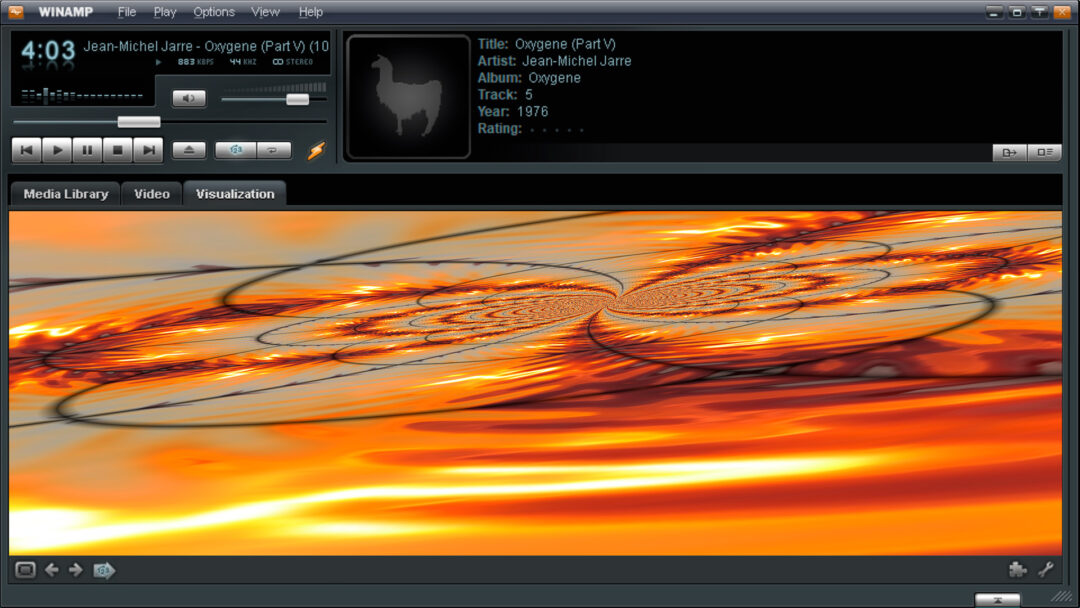If you’re old enough to have partied in the 90s and 00s, this is big news: the very sound of your youth has returned!
More precisely, it’s about the media player Winamp, which has just been released in a new version – after four years of total silence from the developers. And a whole nine years after the program was officially given the deathblow. Winamp was huge in its day, but is this the beginning of a new success for the 25-year-old application?
As important as the Walkman
When the MP3 format appeared in the first half of the 90s, it meant a musical revolution at least as big as when the Walkman made music portable. Now you could transfer music over the emerging internet and store it on your hard drive. Back then, net speed had to be measured in kilobits per second and hard drives in megabytes, so file compression was absolutely essential.
This was made possible by the MP3 format (actually MPEG1 Audio Layer 3), invented by the Fraunhofer Institute. By removing the “redundant” data, the file size could be reduced by 90-95 percent compared to uncompressed wav files ripped from CDs. It was revolutionary – even though the sound quality of the higly compressed files was questionable. Suddenly MP3 files were on everyone’s hard drives and could be swapped with friends in the same way as Pokemon cards. Or downloaded from pirate services like Napster. You could also rip tracks from your own CDs, which the author of this article has spent countless hours doing.
Organising the music
But the music had to be played. And that’s where Winamp came in, in 1997. A small free program with a CD player interface that could play music through the PC’s speakers. But more importantly, Winamp made it easy to organise music files into playlists. And thanks to meta-information stored in MP3 files, files could be organised by genre, album and artist. This had never been seen before.
Although the name reveals that Winamp began as a Windows application, versions have been made for Mac, as well as DOS and Android.
Winamp was easy to use, and you could extend its functions with plug-ins that allowed you to play other file formats or create psychedelic light shows on the screen in time to the music. If you attended a party in the late 90s or early 00s, it’s pretty certain that the music was controlled by Winamp. Yours truly has been the nerd DJ for many a party at the office or at his son’s school. And in far corners of the hard drive there are still folders with names like 70s party and Halloweendisco 2011.

Streaming conquered the MP3 folder
For more than a decade, Winamp was an indispensable application on every music geek’s hard drive. But in 2013, it was over. Music services like Spotify and iTunes had made it possible to play music directly from the internet via your mobile phone, which had by then become a smartphone. It was goodbye to lugging a computer and external hard drives to the party – and hello to millions of online music tracks to choose from. Internet giant AOL, which had paid $80 million for Winamp at the time, closed down the development department.
Nothing’s changed
Since then, Winamp has led a shadowy existence under changing ownership, but largely without development. An updated version was launched in 2018, but with no visible changes or improvements.
Until now, when a new version 5.9 has been launched. The improvements consist of a number of bug fixes, as well as adaptation to Windows 11.
When you open the program, however, the recognizability is unmistakable. Winamp looks like itself. But it must be operated with a magnifying glass. Not only has my eyesight dimmed somewhat over the 25 years that have passed. But the screen resolution has multiplied. Which means the application window is tiny and the font and buttons unreadably small. After some time, however, I managed to find the menu that scales the display to 300% – and makes it possible to see what is going on on the screen.
So what? The reunion is nostalgic, but I don’t think the new release will become a regular part of my daily music listening. And the four years of development will probably turn out to have been wasted effort. For one thing, the streaming services that caused Winamp’s demise in the first place are stronger, more numerous and more popular than ever. And once you’ve got 50 million tracks available on your mobile, it’s hard to imagine ever going back to the MP3 folder on your computer. And even die-hard music collectors like myself have since found easier ways to play the collection of FLAC and MP3 files. In fact, this functionality is now built into any self-respecting multi-room speaker, amplifier or even TV. Along with the ability to supplement with music from all sorts of streaming services.
You can download Winamp 5.9 here.

